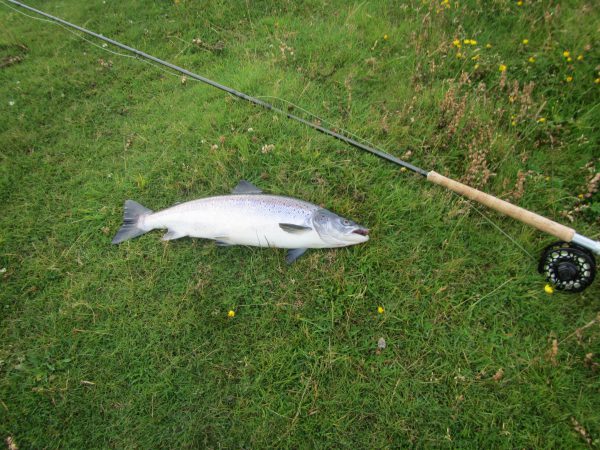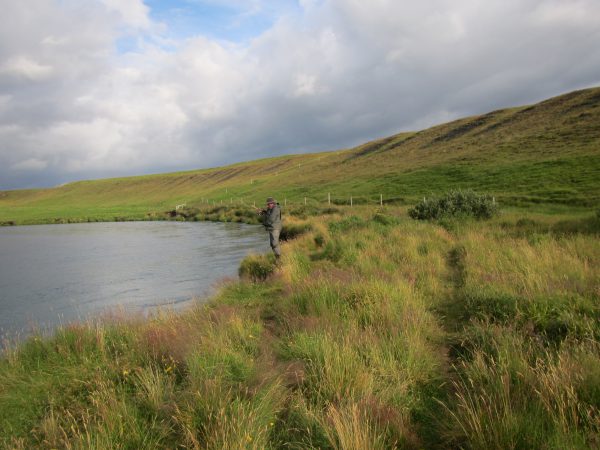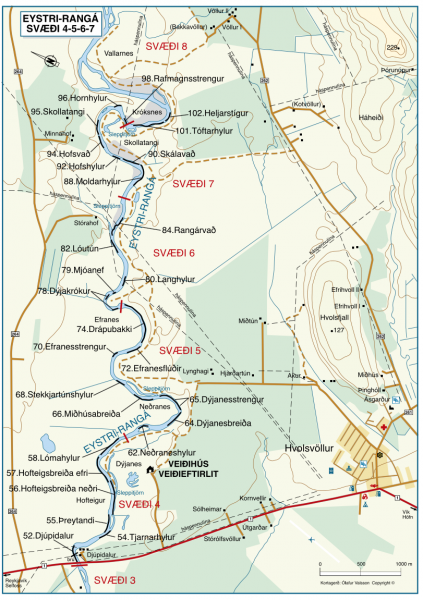
I planned to write about my recent salmon fishing trip in Iceland, but I got stuck on salmon trivia. I also feel that I should first explain briefly how this industry is set up in Iceland. I need to get that off my chest first, as a prequel to the fishing trips.
The Atlantic salmon is a truly magnificent creature. Now there’s a boring sentence! – But to me, it really is so. Just to remind the reader of their life cycle I will undertake to summarize the main points.

Salmon before release – Eystri Rangá
To reach the river, in which it was born to spawn, the salmon faces long odds indeed. The life cycle is from a fertilized egg to the Alevin stage where the fish consume the nutrients of their yolk sac. Then they grow into a form called Parr (those small fish will take small flies). When the time comes for them to venture into the ocean (at 2-8 years) they enter the Smolt stage. The Smolt adapt to the saline environment of the ocean in the estuaries.
http://www.unm.edu/~toolson/salmon_osmoregulation.html
The salt excretion from the seawater poses a new problem for them, which they solve by excreting the salt load through their gills. When the fish returns to sweet water the process must be reversed. Now they can venture into the ocean to grow and reach reproductive size. They are eaten by other predators at all levels of their stages, and very few will ever reach sexual maturity and return to their river of origin. Now the great miracle unfolds. They will unfailingly return to that river. Either after one year in the ocean (these fish are called grilse in the UK) or after 2 years (those are the salmon). As a rule of thumb, the one-year fish will be less than ten pounds and the two-year fish will be more. The salmon must now adapt to freshwater physiology in the estuaries, and still, they face being devoured by seals, for instance, lurking at river mouths. The seals in the estuaries earn the wrath of the river owners who will take appropriate measures. After the salmon are in the river they will not eat at all and would vacuum up all their young ones if they did, and now are fueled by the fat they accumulated in the ocean. Those who survive will travel up the river and take up residence in some pool or run that they like. Freshly run salmon are silvery and will have some sea lice attached, but those will fall off after 24 hours in the river. Then their colors become darker as they wait for the fall and spawning. Every year there will be an influx of grilse (one year in salt) and salmon (two years in salt) to spawn. This is probably nature’s hedge to insure against catastrophes. Nature is sneaky, and some males will not go to sea, but remain and reach sexual maturity. Females need more energy to produce the roe, I suppose. The big males and females will go at it in the fall. The dwarf males wait behind a rock and will snatch any opportunity at fertilization.

Mountain pool
It is a testament to the cynical nature of sapiens that now is the time we fish choose to fish for them. Why do I do it? For me, the thrill is in the “takes” or “strikes.” To swing a small fly near the surface and see the salmon chasing it and finally turn on it in an explosion of power and speed with water splashing is just breathtaking. I really cannot describe this moment or do it justice but it is an incredible moment and it is addictive. The general rule in Iceland is to release all salmon, but keeping a few grilse is allowed. The zeitgeist is moving towards releasing all salmon, and anglers as naturalists and conservationists will not be taken seriously if they keep killing the fish they love. It certainly makes no sense economically to fish for them to obtain food. Homo Islandicus is a peculiar beast, and the subject of catch and release causes more heated exchanges than any other subject on the fishing blogs, some of which are deplorable. I am convinced that in time all salmon caught in Iceland should and must be released.

Eystri Rangá
On top of the takes the salmon rivers are beautiful and some of their pools one would never see if not through the angling. The surrounding scenery can be a bonus, and these rivers are in varied locations and come in different sizes.

Pool at the headwaters
Icelandic rivers are the property of the farms through which they run. The farmers form a syndicate around a river. Then the river banks are divided into “beats” to which a rod is assigned. The number of rods varies depending on the size of the river and on its productivity. One needs to buy a rod license for the rivers well ahead of time. If you do not possess a rod license, then it is ” no cigar.” Below is an example of a “beat” map (svæði). Salmon angling in estuaries is illegal so there is no public access to salmon waters anywhere in Iceland.

Beats 4, 5, 6, 7 Eystri Rangá
The salmon culture in Iceland was probably influenced the most by upper-crust Brits fishing the rivers starting late eighteen hundred and up to the second world war. After the second world war, the anglers came from all over the world. The season is 90 days for each river with different starting days. The best rivers are run with “hotels,” but some are self-catered – understandably the meager ones. The hotels are best described as luxury fishing camps. Each rod gets a private room with two beds and a bathroom. It is customary for two fellow anglers to share a rod. The daily cycle when salmon fishing runs like this: The morning starts with breakfast, and continental it is not. You need your fat and protein to battle the fish. Now we start fishing at 7 AM and fish for solid six hours. At midday, there will be a two-hour break during which there is a shut-eye and lunch because now we are getting hungry. At 3 PM we go at it again and fish for another six hours or until 9 PM. At 10 PM there will be a three-course dinner with aperitifs and digestives. When we finally fall into our beds after midnight we are just whipped, yet are slated to be up again at 5-6 AM. The average salmon angler is usually big with a thick torso and resonant chest. You might think that we sleep soundly after such an ordeal. We do not! Now it is time for the international ensemble of snoring virtuosos. You despair – you must sleep some – but alas, no quarter is given. There is the Austrian going strong, quite melodious, kinsman to Mozart. The Germans go with resounding tones, think Beethoven. Then there is the skirl of the Scots. You get the picture. It is a cacophony of immense quality. Earplugs are an absolute must.
When my fishing buddy shakes me awake next the morning, he greets me with – “my god – you snore like a Brazilian sawmill”.
It truly takes a strong constitution to be a salmon angler.

